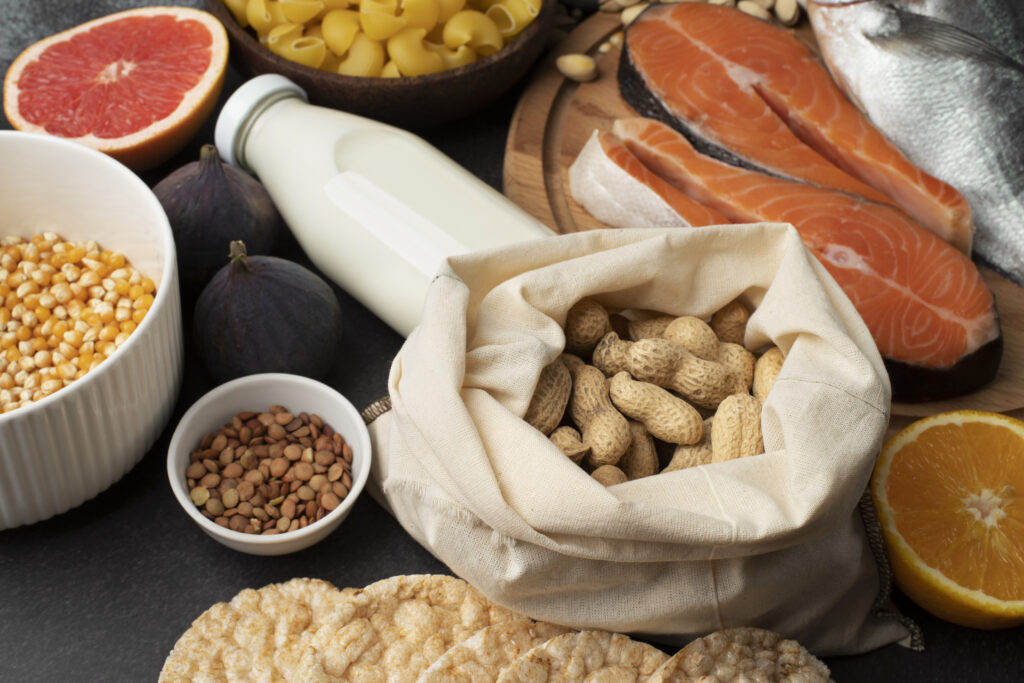So, what should we be feeding our children?
We are the richest nation in the world and have all the resources necessary to provide our children everything they need to grow into healthy adults.
If this is so, why are so many American children sick?
What has gone wrong?
The American children of the modern age have been raised on processed foods made predominantly from soy, wheat, and corn. Soy and corn are generally genetically modified organisms (GMO’s), unless they are organic, and they contain very little nutrients. Wheat, although a modified version of the original form that our ancestors ate, is not always genetically modified. The fact that is has been grown with chemical fertilizers and pesticides, has been refined and is contained in so many products, is what creates a problem.
These three altered carbohydrates, soy, wheat and corn, are converted into sugar by the body. Traditionally, soy was not consumed in the multitudes of ways that it is today. It was not a GMO, and it was only consumed in the fermented form; such as tamari, miso, tempeh. The form that it is seen in today’s market is considered an anti-nutrient food, which actually robs us of nutrients. When Mom shops at the supermarket, her choices are mostly products made out of these ingredients. Unless one knows what to look for, the health food store can be a more pricey extension of what the supermarket carries.
So what ARE the nutrients required for developing bodies? Yes carbohydrates, but in a form that the body knows what to do with. Vegetables are a carbohydrate that contains vitamins and minerals and a lot of fiber to slow down the process as it moves through digestion. This prevents a roller coaster event in the blood stream. The fiber also plays many roles downstream in the process, such as assisting the detoxification process, helping to create essential vitamins in the large intestine and maintaining the integrity of the large intestine. Less fruits and even less fruit juices should be consumed, as they are high in sugars. Some fruits (the lower glycemic ones) can be squeezed with fresh squeezed vegetable juices to make it more appealing; such as apples, pears, or berries.
YES, the large intestine has many roles besides just elimination.
Whole grains that are organically grown and not made into flour, if prepared properly, are a carbohydrate that also contains many useful nutrients and fiber. You see, in order for the body to deal with the sugars produced by carbohydrates, it must have the fiber to manage the speed at which it moves through. The refinement of the grains, besides stripping them of the needed fiber, also removes most of the beneficial nutrients. So, we are left with a refined sludge that creates many problems in the system and offers no benefit; except maybe a sugar rush!
Hopefully, that is not what we want for our children. Stable minds grow out of an even blood sugar regulation. We need the right nutrients for that to occur! About 40% carbohydrates should be included in the meal.

Proteins, which are made from amino acids, are the building blocks of the body.. There are over 50,000 different proteins used to form our organs, nerves, muscles and skin. Unfortunately, most children start their day on anything but that. Always include about 30 % protein with a meal or snack. Besides the benefits of protein, the child will feel more satisfied and not crave the sweets. Even an after school snack may include a healthy hot dog or sausage with some pickles or sauerkraut. This will help to provide energy for homework and other afternoon activities. The usual “witching hour” which often comes before the dinner hour can be avoided.
Fats, which are essential for so many functions of the body including brain development, have been vilified by the Industrial food giants. They have, unfortunately, been replaced by synthetic and improperly produced oils that have run havoc on our health. Polyunsaturated oils should be organically grown and be very carefully prepared and stored or they become deleterious to our health. Avocados are an excellent source of healthy oil. We must not be afraid to consume plenty good quality choices of this very important nutrient (about 30%). Be liberal with the butter (raw if you can find it, Kerigold brand is also good), ghee, organic cold pressed olive oil, walnut oils, coconut oil). Properly prepared nuts (soaked and dehydrated or lightly roasted), are an excellent snack and addition to many foods. Use animal fats in cooking; such as (pasture raised) lard, bacon fat, duck fat, tallow – these supply us with our much needed fat soluble vitamins and they are very stable with high heat. Fats are a nutrient that provides long burning fuel and satiates us to feel satisfied after a meal. We need only look around at our youth who are raised on excessive refined carbohydrates and are suffering from diabetes, obesity, learning disabilities, depression, etc. to understand that one does not get “fat from eating fat”.
Now we can talk about the quality of these nutrients that we will feed children.
First of all, we must keep in mind that children are not just small adults. They are much more vulnerable to the toxic world; since they are not totally developed and their immune systems are still immature. Therefore, their nutrient needs are much greater. It is very important that they receive the utmost nutrient value from their food intake. Twinkles, pop tarts, doughnuts, breakfast cereals, lunchables, derritos, are not exactly nutrient rich food sources. In fact, they are mostly sugar, with some synthetic vitamins (that the body does not recognize and cannot use), and very poor quality oils.
Our proteins sources have been adulterated, so we need to be diligent to find healthy sources. Since cows are ruminants, they need grass to eat in order for the end product to be of good quality and for us receive the essential omega 3’s. Hence, search out good quality meats that have been pastured raised. Organic is not the label you are looking for in this instance, because cows are not meant to be consuming grain. As far as poultry, who are grain consumers, organically fed, pasture raised is what to look for. It is also healthy to consume a variety of meats, such as pork, lamb and organ meats (also pasture raised). If your family is not used these different varieties of meats, they can be prepared in many tasty ways to please the palate. The health benefits are exceptional for these traditional foods that all of our ancestors ate frequently. There are many essential nutrients in these foods that cannot be obtained from any other source. Vitamins cannot replicate what a whole food makes available to us. For healthy seafood look for wild fish, to avoid the impurities and toxins in the farm raised product.
Dairy, if tolerated, can be an excellent source of protein and other nutrients. Best to be consumed raw, if you can find a good source. If you do not have a local raw dairy available, there are many health food stores who carry more commercial brands from small dairy farms. If these are not available, be sure and feed your children organic whole yogurt. This product will contain valuable bacteria to help your child to digest the milk proteins and populate the intestines with beneficial bacteria. Fresh fruit can be added and perhaps even a little wild honey. Stay away from the pre-sweetened varieties as they contain far too much sugar and other questionable substances. Look for raw organic cheeses for easier digestion as well. Many children develop milk allergies due to the premature consumption of poor quality dairy products. Pasteurized dairy is generally from animals that are raised in confinement, with antibiotics, and are not as healthy as grass fed cows.
It’s good to introduce a high protein meal for breakfast; include bacon, sausages, eggs, or protein shake with high quality raw eggs, raw kefir. Try to introduce vegetables at an early age, even for breakfast. Soups, typical of asian fare, and bone broths provide a excellent transition to food after the evening fast
Packing school lunches can be challenging because your child is exposed to lots of un-foods/junk foods in the cafeteria. That is why it is essential to educate your child along the way and encourage them to participate in the food prep. Knowledge is everything. If children are a part of the process, you’d be amazed at how they take it on. Especially if you are creative with the food choices, you will be amazed at how the other children will begin to want what yours have. Making sure that your child has the approximate proportions of fats(30%)/ carbs(40%)/protein(30&) will insure that they have enough energy to make it through their day effectively. Dinner leftovers are a great option. When building sandwiches and such, keep in mind the whole food options described above. Just replace your usual choices with good quality sources.
If you remember the REAL FOOD principle, your childs’ palate will develop to appreciate delicious foods and reject the fake stuff. There are many excellent cookbooks available to assist you on this journey; such as The Nourishing Traditions Book of Baby and Childcare, by Sally Fallon, The Nourished Kitchen by Jennifer McGruther to name a few. Also, consider working with a nutritional therapist, who has the tools to guide you through the process.
Shelley H. Lane, has been practicing oriental medicine since 1984 and later also certified in Nutritional therapy. After so many years of seeing individuals declining health due to poor diet and lifestyle choices, she is directing her work to teaching people about real food choices.




